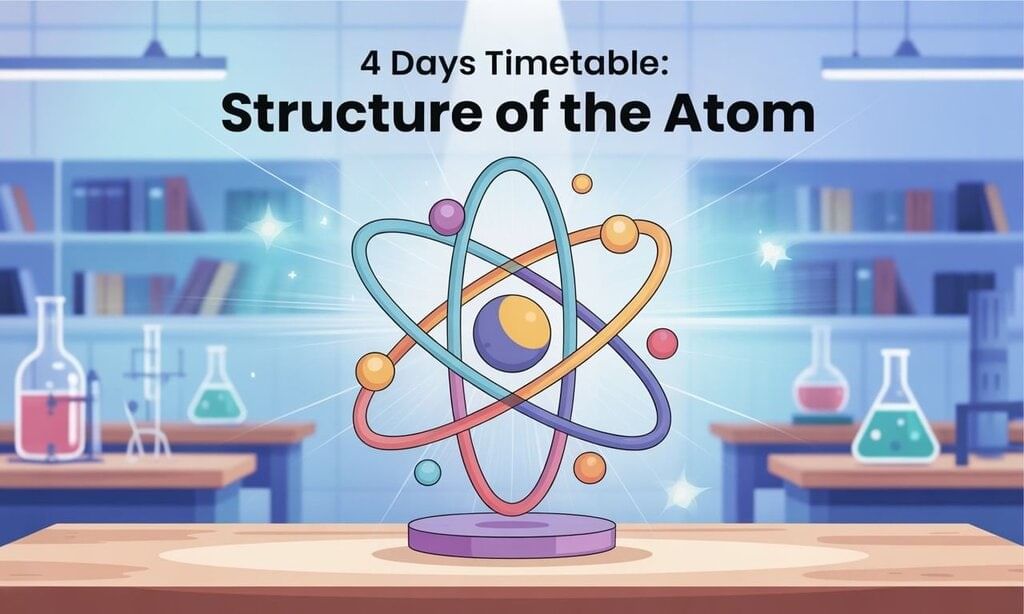4 Days Timetable: Structure of the Atom | Science Class 9 PDF Download
 The chapter "Structure of the Atom" is a fundamental part of the Class 9 Syllabus. This study plan aims to help you develop a clear understanding of the chapter and prepare effectively for your exams.
The chapter "Structure of the Atom" is a fundamental part of the Class 9 Syllabus. This study plan aims to help you develop a clear understanding of the chapter and prepare effectively for your exams.
Topics to Cover
- Charged Particles in Matter
- The Structure of an Atom
- Electrons Distributed in Different Orbits (Shells)
- Valency
- Atomic Number and Mass Number
- Isotopes and Isobars
Day 1: Discovery of Sub-Atomic Particles & Atomic Models
What to cover:
- Charged Particles in Matter
- Discovery of Electrons (J.J. Thomson) and Protons (Goldstein)
- Thomson’s Atomic Model
- Rutherford’s Alpha Scattering Experiment and Nuclear Model
- Drawbacks of Rutherford’s Model
Study tips:
- Begin with the NCERT Textbook for in-depth knowledge.
- Watch related videos on EduRev for visual clarity.
- Solve practice questions to reinforce your understanding.
Day 2: Bohr’s Model, Neutrons, Electron Distribution, Valency, Atomic and Mass Number
What to cover:
- Bohr’s Postulates and Model
- Discovery of Neutrons (J. Chadwick)
- Bohr-Bury Rules for Electron Distribution
- Electronic Configuration and Valency
- Atomic Number and Atomic Mass
Study tips:
- Refer to NCERT Textbook for conceptual clarity.
- Utilise the mind map on EduRev for better retention.
- Practice drawing the atomic structure of each of the 18 elements with the help of Table 4.1 in the NCERT Textbook, mentioning - Composition of Atoms of the First Eighteen Elements with Electron Distribution in Various Shells, and Learn it by heart.
Day 3: Isotopes, Isobars and Yesterday's Revision
What to cover:
- Isotopes
- Isobars
- Reinforce your understanding by revisiting the atomic structures of the first 18 elements using Table 4.1.
Study tips:
- Review the chapter notes and Practice NCERT Solutions on EduRev for quick revision.
- Solve past year questions to check whether you've mastered all key concepts.
- Practice case-based questions to apply your knowledge.
Day 4: Whole Chapter Revision and Testing
What to cover: Revise all topics covered in the previous days. Focus on weak areas and unclear concepts during revision.
Study tips:
- Use the short notes on EduRev for quick revision.
- Test your knowledge by solving topic-wise tests.
- Solve practice questions and assertion and reason type questions for comprehensive testing.
By following this structured study plan and utilising the resources provided, you'll be well-prepared to excel in your Class 9 Science exam, specifically in the chapter on "Structure of the Atom."
Study Resources:
Chapter Resources:
- Previous Year Questions: Structure of the Atom
- Chapter
- Chapter Notes
- NCERT Textbook for Structure of the Atom
- NCERT Solutions for Structure of the Atom
- Worksheet for Structure of the Atom
- Worksheet Solutions for Structure of the Atom
- Short & long questions & answers
- Mindmap: Structure of the Atom
- Practice Questions: Structure of the Atom
- HOTS Questions: Structure of the Atom
- Assertion & Reason type questions: Structure of the Atom
- Case Based Questions: Structure of the Atom
- Long Questions & Answers: Structure of the Atom
- Short Questions & Answers: Structure of the Atom
- Very Short Questions & Answers: Structure of the Atom
- Short Notes
- NCERT Exemplar
- Olympiad Tests
Use these resources to enhance your understanding of the chapter "Structure of the Atom" and ace your exams.
Good luck!
|
84 videos|478 docs|60 tests
|
FAQs on 4 Days Timetable: Structure of the Atom - Science Class 9
| 1. What are sub-atomic particles, and what role do they play in the structure of an atom? |  |
| 2. How did Bohr's model of the atom improve upon previous atomic models? |  |
| 3. What are isotopes and how do they differ from isobars? |  |
| 4. What is the significance of valency in understanding chemical bonding? |  |
| 5. How can an understanding of electron distribution help predict an element's reactivity? |  |






















